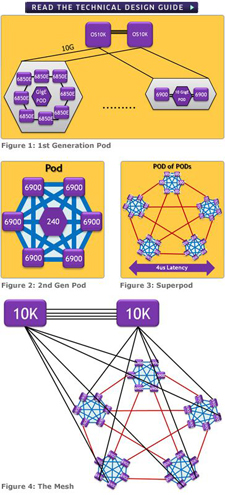Build a Next-Gen Mesh and Pod Architecture Data Center Network
Mesh Architecture
On Access's advanced data center switching fabric creates a “Mesh” network that facilitates private and hybrid cloud computing deployments. The Mesh is formed by connecting smaller "Pods," consisting of several directly connected servers, to each other and to core switches. It can scale linearly from several number of server-facing ports, as the Mesh provides resilient and low-latency any-to-any connectivity. Moreover, with 40GigE (and, coming soon, 100GigE) connections, along with Shortest Path Bridging (SPB), Virtual Chassis, Loss-less Ethernet, and thousands of 10 GigE server ports, the On Access Mesh architecture ensures the quality delivery of real-time applications for the future, while reducing costs and operational complexity.
Architecture flexibility allows a cost effective solution for a complete range of customers – from the small server farm interconnections to the core network to massively sized multi-site data centers, all while enabling customers to deploy the solution along side existing, older-generation networking components while taking advantage of the innovative, low-latency capabilities of the mesh.
1st and 2nd Gen Pods
The building block approach to a mesh network begins with the creation of a Pod, the logical entity of several units connected together and managed as a single unit. First generation Pods, which are based on the swiftSwitch 7870E Stackable LAN Switch series, consist of up to eight units using traditional stacking technology (see Figure 1). Second generation Pods will be based on meshed swiftSwitch7870s, using SPB for inter-unit connectivity. The accompanying second generation Pod diagram (Figure 2) illustrates the inter-switch connections of OS 7870s with 40GigE and SPB.
The Superpod
A Superpod ties multiple Pods together before connecting to the core. Latency is minimized by utilizing SPB, with traffic flowing directly between destinations and thus avoiding the core. This allows intra-Pod and intra-Superpod traffic to stay local within the Superpod entity. By minimizing connections to three or fewer “hops”, end-to-end latency is kept at or below 4 microseconds. Superpods are built on SPB and 40GigE technology and will be available in mid-previous Year (see Figure 3).
The Mesh
Building on the Superpod, the Mesh combines the power of the OS 7900 with the OS 15K Modular LAN Chassis, which serves as the data center switching fabric core. The two products together form Mesh architecture with 40GigE connections from each Superpod to an OS 10K as illustrated in Figure 4 below.
The shortest path between any two ports is minimized to increase speed and reduce network latency. By optimizing interconnections, packets are quickly delivered to as many nodes as possible. In some Pod configurations, not all units are fully meshed; however, Superpods can be configured to provide the lowest optimal aggregate latency by maximizing the number of meshed units.

-
Need More
Information? -
 Send
Send
us an inquiry -
 Start
Start
live web chat -
 Find
Find
a reseller near you





